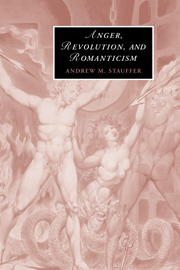Book contents
- Frontmatter
- Contents
- Acknowledgments
- List of abbreviations
- Introduction: fits of rage
- 1 Towards Romantic anger
- 2 Burke, Coleridge, and the rage for indignation
- 3 Inflammatory reactions
- 4 Provocation and the plot of anger
- 5 Shelley and the masks of anger
- 6 Byron's curse
- Epilogue
- Notes
- Bibliography
- Index
- CAMBRIDGE STUDIES IN ROMANTICISM
Introduction: fits of rage
Published online by Cambridge University Press: 22 September 2009
- Frontmatter
- Contents
- Acknowledgments
- List of abbreviations
- Introduction: fits of rage
- 1 Towards Romantic anger
- 2 Burke, Coleridge, and the rage for indignation
- 3 Inflammatory reactions
- 4 Provocation and the plot of anger
- 5 Shelley and the masks of anger
- 6 Byron's curse
- Epilogue
- Notes
- Bibliography
- Index
- CAMBRIDGE STUDIES IN ROMANTICISM
Summary
The men who grow angry with corruption, and impatient at injustice, and through those sentiments favour the abettor of revolution, have an obvious apology to palliate their error; theirs is the excess of a virtuous feeling. At the same time, however amiable may be the source of their error, the error itself is probably fraught with consequences pernicious to mankind.
– Godwin, “On Revolutions,” Enquiry Concerning Political Justice, 1793And the just man rages in the wilds
Where lions roam.
– Blake, “The Argument,” The Marriage of Heaven and Hell, 1789In the latter part of the eighteenth century, two closely related developments in Europe changed utterly the functions and forms of anger in public discourse. First, the French Revolution inspired intense debate over anger's role in, and in creating, new forms of civil society. From its beginnings, the Revolution was centered in an assertion that the anger of the people deserved respect, and had a legitimacy of its own. Yet as they democratized anger, the Revolution and the Terror demonstrated the dangers of unbounded public rage, leaving conflict an ambiguous inheritance for English writers. Second, the periodical press began a phase of rapid expansion that transformed the substance, style, and reach of the public voice. Printing technologies allowed for the dissemination of angry rhetoric across lines of class and nation, and helped establish the right of an outraged people to redress.
- Type
- Chapter
- Information
- Anger, Revolution, and Romanticism , pp. 1 - 15Publisher: Cambridge University PressPrint publication year: 2005



